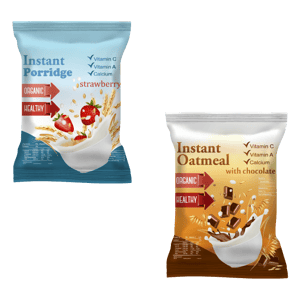Inks for Food Packaging: Standards & Guidelines

It's not a secret, but it may be overlooked: Packaging is everything.
When we grocery shop, what packaging our favorite brands wrap or place their products in plays a huge role in what we choose to buy. What becomes a brand we identity with, and what we continue to buy each time we have to stock up may all start with the logos or printed information that is written on a package.
But, do consumers look further than just the words, characters, or logos they see when browsing up and down the aisle? Probably not. However, food packaging plants do.
The Importance of Safe Inks in Food Packaging
Even though consumers don't think about the inks that are printed on a package, they play an important role in the safety of the food they buy. This is not just for packaging, but for the marking and coding of expiration dates and barcodes that rest in close proximity to food.
The inks used in food packaging must be carefully chosen to avoid any risk of contamination that could compromise food safety. Inks can potentially migrate through packaging materials and come into contact with the food, making it crucial to use formulations that are non-toxic and stable. Safe inks help maintain the integrity of the food, ensuring that consumers receive products that meet high safety and quality standards.
The choice of ink not only ensures compliance with safety standards but also plays a pivotal role in maintaining the integrity of the product's branding and information. From flexible packaging to substrates exposed to moisture, the criteria for ink selection are diverse and demand a comprehensive understanding.

So what criteria should inks to meet in order to be used for packaging?
- Substrate Compatibility: The material of the packaging—whether plastic, glass, or paper—dictates the type of ink that will adhere effectively. For instance, non-porous substrates like metal or waxed paper require specialized inks for optimal performance.
- Color and Dry Time: The ink color must be vibrant and contrast well with the packaging to ensure legibility, while dry time affects production efficiency. Quick-drying inks are essential for high-speed production lines to avoid smudging.
- Moisture Resistance: Products like frozen foods or those stored in damp environments need inks that withstand moisture without losing adhesion or legibility.
- Durability and Versatility: Inks must retain their imprint over the product's lifecycle, enduring handling, transportation, and storage conditions.
Safety Standards and Compliance
Regulatory bodies such as the FDA in the United States and the European Union have established comprehensive guidelines to ensure the safe use of inks in food packaging. These regulations outline permissible ink components, migration limits, and other safety criteria that must be met to protect public health.
The longer these components linger next to your food, the higher the chance they might migrate, potentially leading to contamination

Migration Limits: What are they?
Migration refers to the movement of substances from the packaging into the food product itself. These substances can come from various sources such as inks, adhesives, varnishes, or even the packaging material.
Several factors can influence how fast and how much migration occurs. This includes the type of food being packaged, the temperature at which it's stored, and the nature of the packaging materials. Each of these elements can affect the migration process differently, making it essential to consider them when designing and choosing packaging.
- Penetration Through the Substrate: This occurs when substances move directly through the material of the packaging, reaching the food inside.
- Set-Off Transfer: Imagine a stack of packaging materials. Sometimes, components transfer from one layer to the next, reaching the side that contacts the food.
- Vapor Phase Transfer: In this process, substances migrate in a gaseous form. This can happen even without direct contact, as the components vaporize and move through the air within the package.
Benefits of Choosing TROY Group's Inks
TROY Group has established itself as a leader in providing inks that meet and exceed these stringent safety standards. Our inks are formulated with the utmost care, ensuring they are free from harmful substances and compliant with FDA and EU regulations. Our inks are designed to offer superior performance without compromising safety. They are rigorously tested for migration limits, ensuring they remain stable and non-reactive under various environmental conditions. This makes them ideal for maintaining the quality and safety of packaged foods throughout their shelf life.
TROY Group offers a options specifically designed for these applications: Low-Migration UV/LED-Curable Inks, formulated to minimize the risk of contamination. Water-Based LUNAJET Ink, which are eco-friendly and safe for food packaging applications.
Other benefits:
- Regulatory Compliance: TROY Group inks are developed in strict accordance with global safety standards, making them a reliable choice for food packaging.
- Consumer Safety: Our inks minimize the risk of contamination, helping to protect consumer health and uphold brand integrity.
- Quality Assurance: With proven stability and performance, our inks maintain the visual appeal and information integrity of packaging without compromising safety.
- Trust and Reliability: By choosing TROY Group, manufacturers partner with a trusted leader in the industry known for its commitment to excellence and safety.
The role of inks in food packaging is crucial in safeguarding consumer health and ensuring compliance with safety standards. TROY Group's ink solutions not only meet but exceed these requirements, providing a dependable choice for manufacturers dedicated to producing safe and high-quality food products.
Contact us today so we can help you create custom inks tailored for your needs.
Related Posts

What is UV Printing? UV Curable Inks for Packaging
Ultraviolet, or UV printing is an advanced digital technology that cures specially designed inks using UV light. This process creates sleek, vibrant designs that dry instantly,..

Here's How to Beat Upcoming Postage Rate Increases
In 2024, a notable increase in postage costs became a reality. With postage increases expected to occur multiple times a year, it's important to be prepared for what's coming.

What is MICR Toner? A Guide for Check Printing
What is MICR? MICR stands for Magentic Ink Character Recognition, and it plays a critical role in check printing. If you're printing checks for your business, you should always be..



Leave a Reply